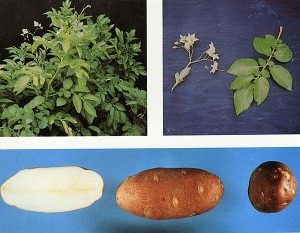Russet Burbank (Solanum tuberosum)
SYNONYMS: Idaho Russet, Netted Gem
ORIGIN: The origin of Russet Burbank was reported by Luther Burbank in 1914 as being a chimera selected from the variety Burbank by Lou Sweet. Lou Sweet was a potato grower in the western slope area of Colorado and was President of the Potato Association of America in 1920.
CHARACTERISTICS: A late maturing variety that requires a 140 to 150 day growing season to produce maximum yields and quality. Yields are moderately high ranging from 250 to 600 cwt/A (28 to 67 t/ha). The cultivar is well adapted and primarily grown with irrigation in the northwestern states of Idaho, Washington, Oregon, Montana, and in Canada. It is also grown in several north-central and mid-western states.
Plants are vigorous, spreading and have an indeterminate type of growth. Stems are thick, prominently angled and finely mottled. Leaflets are long, medium in width and light to medium green in color. The blossoms are few, white and not fertile. Tubers are large, long and cylindrical or slightly flattened with russeted skin. They eyes are shallow and the flesh is white.
STRENGTHS & WEAKNESSES: The variety is the standard for excellent baking and processing quality. The cultivar is tolerant to common scab but is susceptible to Fusarium and Verticillium wilts, leafroll and net necrosis and virus Y. Jelly-end and sugar-end develop in tubers when plants are subjected to stress. Plants require conditions of high and uniform soil moisture and controlled nitrogen fertility to produce tubers free from knobs, pointed ends and dumbbells. It is a good long-term storage potato for tablestock and processing.
